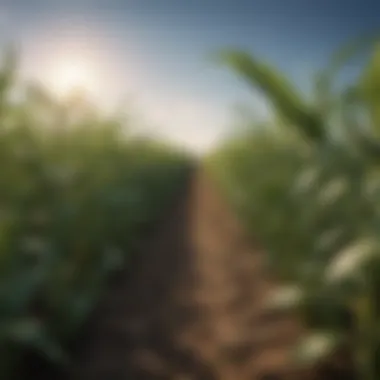Exploring Agriculture's Technological Transformation


Intro
In the current era, the agricultural landscape is undergoing a significant transformation due to the influence of technology. Farmers and agribusinesses increasingly rely on sophisticated tools and methods to optimize efficiency and yield. The intersection of agriculture and technology is reshaping how food is produced, distributed, and consumed. This article will explore the fundamental concepts and current trends that characterize this intersection and will provide insights on the practical applications of these technologies.
Key Concepts and Terminology
Basic Definitions
Understanding the interplay between agriculture and technology requires some baseline definitions.
- Precision Farming: This refers to agricultural practices that use data analysis and sensing technologies to manage crops and increase their yield.
- Automation: In agriculture, this involves the use of robotics and machinery to perform tasks that were traditionally done by human labor.
- Genetic Engineering: This process involves modifying the DNA of crops to enhance desired traits such as increased resistance to pests or improved nutritional content.
Historical Context
Agriculture has always evolved, but the pace has quickened recently. From the invention of the plow to the industrial revolution, technology has played a vital role in agricultural development. The introduction of tractors in the early 20th century marked a shift towards mechanization. Today, innovations such as drones and artificial intelligence are revolutionizing the sector even further. Understanding this history allows us to appreciate the current advancements.
Recent Innovations and Trends
Technological Advancements
Recent innovations in technology are changing how agricultural practices are executed. These include:
- Drones: Used for crop monitoring and land surveying, providing real-time data to farmers.
- Soil Sensors: Devices that measure soil moisture and nutrient levels, enabling targeted irrigation and fertilization.
- Robotic Harvesting: Machines that can pick fruits and vegetables, helping address labor shortages.
Sustainable Practices
Technology in agriculture is not just about increasing yields. It also focuses on sustainability. Techniques such as crop rotation, integrated pest management, and organic farming are being combined with technological advancements. This synergy promotes environmental health and resource conservation.
Practical Applications and Techniques
Step-by-step Guides
Implementing technology in agriculture can be daunting but manageable. Here is a simplified process for adopting precision farming:
- Data Collection: Use sensors or drones to gather data on crop health and soil conditions.
- Data Analysis: Analyze the collected data to identify areas needing attention.
- Targeted Action: Implement specific measures, such as variable rate fertilization, based on analysis.
- Monitoring: Continuously monitor results and adjust practices accordingly.
Case Studies
Examining real-world applications sheds light on the effectiveness of technology in agriculture. For instance, a notable case is the University of California study on the use of UAVs (Unmanned Aerial Vehicles) in vineyards. By capturing data on vine health through aerial imagery, vineyards significantly improved their water management and pesticide application.
"Technology in agriculture not only maximizes yield but also promotes responsible practices that are vital for sustainable development."
Prelude to Technology in Agriculture
The integration of technology in agriculture has emerged as a significant turning point in the industry's evolution. Understanding this intersection is vital for appreciating the shifts that modern agriculture undergoes today. Cellular and molecular biology, data analytics, and machinery automation all play crucial roles. Farmers can incorporate these advanced methods to enhance productivity, efficiency, and sustainability.
The development of technology has enabled farmers to overcome various challenges. Climate change, soil degradation, and population growth stress the agricultural sector. These issues prompt the need for innovation, providing opportunities for improved agronomic practices.
The benefits of employing technology in agriculture are manifold. For instance, precision farming techniques allow for data-driven decision-making, which can lead to increased crop yields and enhanced resource management. Similarly, automation in tasks like planting, monitoring, and harvesting can free labor resources while maximizing output. Understanding how these technological advances operate in practice grants valuable insights into effective agricultural strategies.
Fostering an awareness of the current technological landscape invites a discussion on the societal and ecological considerations tied to these advancements. Potential ethical dilemmas arise, especially surrounding genetic engineering and data usage. Appreciating the implications these factors might have on future agricultural practices is essential for professionals and enthusiasts alike.
In this section of the article, we will begin by examining the historical context of agricultural technology, leading to an overview of current technological trends that are reshaping the industry.
Precision Farming Techniques
Precision farming techniques have become indispensable in the modern agricultural landscape. By utilizing technology, farmers can enhance productivity, reduce waste, and optimize resource use. This approach promotes efficient farming practices while addressing some of the key challenges in agriculture, such as climate variability and resource scarcity.


Definition and Overview
Precision farming, often known as precision agriculture, refers to the practice of managing fields in a way that observes and responds to variability in the environment. This method uses data-driven solutions to monitor crop and soil conditions, enabling farmers to make more informed decisions. The primary goals are to increase crop yields, enhance sustainability, and maximize efficiencies while minimizing inputs such as water and fertilizers.
Tools and Technologies
The success of precision farming relies on several tools and technologies that help gather and analyze data. These technologies include:
- GPS Technology
- Remote Sensing
GPS Technology
GPS technology is crucial for precision farming, enabling precise location tracking of equipment and crops. This technology allows farmers to apply resources in specific areas based on need, rather than uniformly throughout the fields. A key characteristic of GPS is its ability to provide accurate positioning, often down to a few centimeters. This accuracy is beneficial in allowing farmers to optimize planting strategies and resource allocation. The unique feature of GPS technology in precision agriculture is its integration with other tools such as automated machinery, which enhances efficiency further. However, GPS systems may have limitations, such as signal interference in hilly terrain or heavy vegetation.
Remote Sensing
Remote sensing refers to the technique of obtaining information about objects or areas from a distance. This is usually done using drones or satellites equipped with sensors. A key characteristic is its ability to capture data about crop health, soil moisture, and land usage without the need for physical presence on-site. This technology is considered beneficial as it allows for regular monitoring of large areas effectively. One unique feature of remote sensing is its ability to use multispectral images to assess crop conditions, which can lead to better management decisions. However, one disadvantage might include the requirement for significant data analysis skills to interpret the information accurately.
Impact on Crop Yield
The impact of precision farming on crop yield cannot be overstated. Implementing precision farming techniques can significantly increase productivity by enabling farmers to tailor their practices to the specific needs of their crops and soil. By utilizing data on soil health, moisture levels, and nutrient content, farmers can apply the right amount of fertilizers and pesticides, leading to healthier crops and higher yields. Ultimately, precision farming not only supports increased productivity but also contributes to sustainable agricultural practices, aligning with the growing focus on environmentally responsible farming.
Automation in Agriculture
Automation in agriculture plays a pivotal role in redefining how farming practices operate. It embraces a range of technologies that assist farmers in executing farm tasks more efficiently and effectively. This section explores various facets of agricultural automation, highlighting its significance, benefits, and the necessary considerations for successful implementation.
Overview of Agricultural Robotics
Agricultural robotics has emerged as a key component of automation within the sector. These robots are designed to perform specific tasks, reducing the reliance on human labor. From planting seeds to monitoring crop health, they provide precision and consistency in executing tasks. Notably, robotics facilitates the handling of labor shortages, especially in regions where manual labor is difficult to secure.
The advantages of these systems include increased productivity and enhanced accuracy. With the ability to operate in diverse conditions, agricultural robots adapt to various environments, making them a valuable asset for modern farms.
Case Studies
Robotic Harvesters
Robotic harvesters represent a significant innovation in harvesting processes. Designed to autonomously gather crops, these machines combine complex sensory technologies with machine learning algorithms. Their primary contribution to agriculture lies in their ability to harvest crops with precision, minimizing damage and waste.
- Key Characteristic: The standout feature of robotic harvesters is their intelligent harvesting mechanism. They make real-time decisions based on the ripeness of fruit and the surrounding environment. This capability ensures that crops are picked at peak quality, leading to better market prices.
- Advantages: Robotic harvesters can operate long hours without fatigue. They reduce labor costs and enable farms to scale operations without increasing labor force. Furthermore, they assist in handling labor shortages that many farmers face today.
- Disadvantages: The initial cost of acquisition is relatively high. Maintenance and technical expertise are also required, which can be a barrier for smaller farms.
Drones in Plant Health Monitoring
Drones have transformed how farmers monitor plant health. These devices equipped with high-resolution cameras and sensors provide invaluable data on crop conditions. They allow for continuous monitoring of large areas, aiding in the early detection of issues such as pests and diseases.
- Key Characteristic: The use of infrared sensors enables drones to assess the health of plants by analyzing light reflectivity. This feature allows farmers to identify stressed plants quickly and address problems before they escalate.
- Advantages: Drones offer a cost-effective solution for monitoring vast fields. They can gather data rapidly, providing insights that help in making informed decisions. The visual data obtained can lead to optimized resource use, such as targeted pesticide application.
- Disadvantages: Regulatory considerations around drone usage can pose challenges. Farmers must ensure compliance with local laws regarding drone operations, which can limit how and when these technologies can be utilized.
"The integration of automation in agriculture not only improves efficiency but also helps in making farming more sustainable."
In summary, the automation of agriculture is not only about replacing labor but enhancing the accuracy and efficiency of farm operations. As technology continues to evolve, the potential for greater integration of robotics and drones will likely create a more responsive and sustainable agricultural framework.
Genetic Engineering and Biotechnology
Genetic engineering and biotechnology represent transformative elements within the agricultural sector. They introduce innovative methods to enhance food production, improve crop resilience, and address nutritional challenges. This section explores the mechanics of genetic modification, its associated benefits, and the ethical considerations that accompany these advancements. Understanding the intricacies of genetic engineering is crucial for evaluating its implications on sustainable agriculture.
Basics of Genetic Modification
Genetic modification involves altering the genetic makeup of living organisms to achieve desired traits. This process is often executed through techniques like CRISPR, which enables precise edits in DNA sequences. The goal of genetic modification in agriculture is to develop crops that exhibit specific advantageous traits, such as increased yield, pest resistance, or improved nutritional content. By understanding the mechanisms behind genetic modification, farmers can make informed decisions about adopting genetically engineered crops to maximize productivity while minimizing environmental impact.
Benefits of Biotechnology


Increased Resistance to Pests
The capacity for increased pest resistance is one of the most compelling benefits of biotechnology. Genetically engineered crops, such as those developed by Monsanto, often produce proteins that are toxic to specific insect pests while remaining harmless to beneficial insects and humans. This targeted approach can lead to reduced reliance on chemical pesticides, ultimately benefiting both the environment and farmer's health.
Moreover, these crops can significantly reduce crop damage, leading to higher yields. The unique feature of pest-resistant crops is their ability to withstand pest infestations without compromising overall plant health. Consequently, farmers experience lower operational costs and improved profit margins.
Enhanced Nutritional Content
Enhanced nutritional content is another critical advantage of biotechnology in agriculture. Genetically modified organisms, like Golden Rice, have been engineered to contain vitamin A, addressing malnutrition in populations dependent on rice as a staple food. The key characteristic here is that these crops are fortified with essential vitamins and minerals, making them particularly suitable for food security programs.
The unique aspect of enhancing nutritional content lies in its dual benefit: addressing immediate dietary deficiencies while promoting sustainable agriculture. However, there are discussions about the long-term impacts of consuming genetically modified produce. Balancing these considerations plays a vital role in the acceptance of biotechnology in diverse agricultural practices.
Controversies and Ethical Issues
While the advancements in genetic engineering and biotechnology present numerous benefits, they also raise significant ethical dilemmas and controversies. Concerns about potential environmental impacts, such as loss of biodiversity or the emergence of superweeds, are pertinent. Additionally, the ownership and control of genetically engineered crops by large corporations can lead to monopolistic practices, affecting smallholder farmers.
Public perception of genetically modified organisms can be polarized, complicating the conversation around their use. Some advocate for stricter regulations and clearer labeling, allowing consumers to make informed choices. Engaging with these ethical issues becomes essential for policymakers, educators, and farmers aiming to foster sustainable agricultural practices.
"As agriculture becomes more intertwined with technology, the need for transparent dialogue on genetic engineering is more crucial than ever."
By scrutinizing these aspects, stakeholders can work towards solutions that ensure advancements serve the greater good without forsaking ethical responsibilities.
Sustainable Agricultural Practices
Sustainable agricultural practices are increasingly crucial in modern agriculture. They focus on meeting current food production needs without compromising the ability of future generations to meet their own needs. This approach promotes environmental health, economic profitability, and social equity. By implementing sustainable methods, farmers can ensure that agriculture remains viable in the long term while minimizing harm to the ecosystem.
Importance of Sustainability
Sustainability in agriculture plays a fundamental role in addressing climate change, biodiversity loss, and food security. It is essential to mitigate the negative effects of conventional farming, such as soil degradation and water overuse. Sustainable practices aim to improve resilience against climate variability, which can affect crop yields. They promote the responsible use of resources, ultimately leading to healthier ecosystems and communities. By adopting these practices, farmers not only enhance their productivity but also contribute positively to global environmental goals.
Role of Technology in Sustainability
Technology serves as a pivotal element in advancing sustainable agricultural practices. Innovations such as precision farming tools, data analytics, and advanced irrigation systems help farmers optimize resource use. For instance, smart irrigation systems reduce water consumption by delivering precise amounts when needed. Additionally, technologies like drones facilitate monitoring of crop health and soil conditions, enabling targeted interventions that minimize waste. These tools help in creating a more sustainable agricultural framework while boosting efficiency and productivity.
Examples of Sustainable Practices
-#### Soil Conservation
Soil conservation is an essential practice that contributes significantly to sustainable agriculture. It refers to methods aimed at preventing soil erosion and degradation. One key characteristic of soil conservation is its focus on maintaining soil health by utilizing techniques like cover cropping and crop rotation. These methods not only improve soil fertility but also enhance biodiversity. The unique feature of soil conservation is its ability to lock in carbon, thus playing a role in mitigating climate change. However, implementing these practices may require an initial investment and a learning curve for some farmers.
-#### Water Management
Water management is another critical aspect of sustainable agricultural practices. Effective water management ensures that water resources are used efficiently, minimizing waste and enhancing crop resilience. A key characteristic of this practice is the incorporation of techniques like rainwater harvesting and drip irrigation systems, which provide crops with the precise amount of water they need. The unique feature of water management lies in its potential to safeguard water sources while improving yield. A downside may include the costs associated with installing advanced technologies, but the long-term benefits often outweigh these initial investments.
"Sustainable practices lead to healthier soils and better productivity, ensuring a secure food source for the future."
By understanding and applying these practices, agricultural stakeholders can contribute to an environmentally sound future.
Challenges Facing Modern Agriculture
Modern agriculture is at a crossroads, where traditional methods meet rapid technological advancements. However, many challenges critically affect the sector's ability to evolve. Understanding these challenges is essential for farmers and technology developers alike. Two significant challenges are economic constraints and regulatory barriers. Each presents unique hurdles that stakeholders must address to harness the full potential of technology in agriculture.
Economic Constraints
Economic constraints refer to the financial limitations that producers face when adopting new technologies. The cost of implementing advanced agricultural practices can be prohibitive, especially for smallholder farms. This poses a barrier, as many farmers have limited access to capital. Moreover, fluctuations in commodity prices can create uncertainty, making it difficult for farmers to invest in long-term solutions.
Farmers often weigh the potential benefits of investing in technologies against the immediate costs. Technologies such as precision agriculture require upfront investment in equipment and training, which can be challenging to justify when facing current economic pressures. Compounding these costs are maintenance expenses and the need for ongoing education in new technologies that are essential for leveraging the investments.
- Key economic issues include:


- High initial costs for technology adoption
- Unstable market prices affecting income
- Limited access to financing options
Additionally, larger agribusinesses might have more resources to allocate to technology, leaving smaller farms at a disadvantage. This imbalance not only affects competition but also contributes to shrinking agricultural diversity, as fewer farmers can participate in innovative practices.
Regulatory Barriers
Regulatory barriers present another complex challenge for modern agriculture. These barriers consist of government regulations that may limit how farmers can use advanced technologies. Regulatory frameworks can differ widely from one region to another, creating complications for farmers who operate across state or national borders.
One critical area of regulatory concern is genetic modification. While technological advancements in genetic engineering have pushed the boundaries of crop resilience and yield, strict regulations can hinder research and application. Farmers may find themselves with limited options for crops that could enhance their viability against pests and climate changes due to stringent approval processes.
- Specific regulatory challenges include:
- Lengthy approval processes for new agricultural technologies
- Variation in regulations across jurisdictions
- Resistance to adopting new technologies due to fear of penalties
Furthermore, regulatory inconsistency can stifle innovation. If farmers are uncertain about which technologies will be permissible in the future, they may delay or forgo investments altogether. This cautious approach can slow the pace of technological integration into agriculture, ultimately impacting productivity and sustainability goals.
"Adapting agricultural practices to meet regulatory demands without stifling innovation is a delicate balance that must be struck."
Understanding the economic and regulatory challenges in modern agriculture is crucial for navigating the future landscape. Addressing these barriers can help unlock the potential of technology, leading to more sustainable and productive agricultural practices.
The Future of Agriculture
The future of agriculture holds significant importance, as it shapes how food is produced in a rapidly changing world. With increasing global populations and environmental challenges, understanding this future becomes essential for sustainable growth. Technology will play a pivotal role in transforming agricultural practices, allowing farmers to meet rising food demands while minimizing environmental impact.
Emerging technologies promise numerous benefits. They enhance efficiency and productivity through data-driven insights, automation, and advanced genetics. Farmers are now better equipped to make decisions based on real-time data, leading to improved crop yield and resource management.
Furthermore, technology can support sustainability, addressing critical challenges like climate change and soil degradation. It can facilitate better water use, optimize fertilizer application, and promote biodiversity. Therefore, the topic provides rich ground for exploration, examining how innovations will change traditional farming in the coming years.
Emerging Technologies
In discussing the future, it is also vital to consider specific emerging technologies that will shape agriculture. Several innovations stand out:
- Blockchain: It provides transparency in supply chains. Farmers can trace produce from the field to the consumer, ensuring quality and safety.
- Artificial Intelligence: AI can analyze vast amounts of data, helping farmers predict crop failures and optimize farming practices.
- Vertical Farming: This approach utilizes controlled environments to grow crops year-round, maximizing space and reducing the need for pesticides.
These technologies not only increase yield but also promote more efficient resource use. They offer solutions tailored to modern challenges, ensuring that agriculture adapts to new realities.
Predicted Trends
As technology continues to advance, several trends are predicted for agriculture:
- Increased Use of Robotics: Automation in tasks like planting and harvesting will grow. This will help address labor shortages and increase efficiency.
- Integration of IoT: Internet of Things devices will connect various components of farming, enabling smarter systems for monitoring and management.
- Focus on Data Analysis: The ability to harness and interpret data will become essential, leading to more precise farming decisions.
- Sustainable Practices: An ongoing shift toward environmentally friendly methods will become increasingly important, driven by consumer demand for sustainable products.
"Emerging technologies will not only enhance productivity but also encourage more sustainable farming practices."
Finale
The conclusion serves as the final reflection on the intricate relationship between technology and agriculture. It encapsulates the key takeaways from the examination of modern agricultural practices, highlighting how innovations are reshaping the landscape. Not just a summary, it connects the dots between technology and its implications for sustainable farming.
One important element of the conclusion is its emphasis on the importance of sustainable practices. As agriculture faces pressing challenges like climate change and resource scarcity, technological solutions offer ways to mitigate these issues. Precision farming techniques allow farmers to optimize inputs, thus enhancing efficiency while reducing waste. This not only leads to higher crop yields but also promotes environmental stewardship.
Moreover, the ethical considerations surrounding genetic engineering become increasingly relevant. While biotechnology holds the promise of improved resilience against pests and diseases, it also raises questions regarding food safety and environmental impact. Discussions around these ethics must be ongoing as farmers adopt such technologies.
Ultimately, the conclusion synthesizes various viewpoints, urging a balanced approach between embracing technology and being mindful of its effects. It reinforces the notion that agriculture must evolve, but evolution should not come at the cost of ethical standards or environmental degradation.
Summary of Key Points
- Technological Advancements: Technologies such as precision farming, automation, and biotechnology are changing agriculture significantly.
- Sustainability: There is a critical need for sustainable practices to address environmental issues while maintaining productivity.
- Ethical Dilemmas: The adoption of new technologies raises important ethical questions that require careful consideration.
- Future Considerations: Continued dialogue and research are necessary to ensure that technology serves the best interests of farmers and the environment.
Final Thoughts
As new technologies emerge, adaptability and education become essential. Participating in dialogues within agriculture communities, on platforms like Reddit or Facebook, can provide valuable insights. Embracing technology is not merely about adopting new tools; it involves understanding their implications and integrating them into farming practices for a sustainable future.
"In the changing world of agriculture, informed choices pave the way for prosperity and sustainability."
By focusing on these elements, stakeholders can remain at the forefront of agricultural innovation, fostering growth that is economically viable and environmentally sound.















